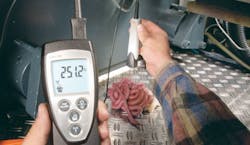For HVAC Systems, Efficiency Measurements Are The "Delta" Difference
When measuring the performance of an HVAC system, the term 'delta' is often used to express the difference between two measurements. Let’s take a look at the family of HVAC industry “deltas” that we include in our day-to-day HVAC slang terms:
Delta T, Delta P, Delta V, and Delta H. Let's add Delta C too.
Besides the “difference between two related measurements” that we use, the word delta has an interesting history. Going way back, Delta or “Δ” just happens to be the fourth letter of the Greek alphabet. The name came from the appearance of a three-sided island that forms where two rivers meet. From there, any symbol that looks like a triangle also became known as a delta.
Delta T
“Delta T” is the most common use of the word 'delta' in the HVAC industry, meaning temperature difference. If the temperature before a cooling coil is 75°F and the temperature after the cooling coil is 55°F, subtract 55°F from a 75°F to find a Delta T of 20°F.
Since the first time a service technician tried to explain delta to me, I’ve wrestled with a way to make the definition a little easier to swallow. It took him 20 minutes and I went away scratching my head. Remember that when talking to new technicians or the office staff. Take time to explain delta to those who need to become familiar with this valuable term.
Delta P
In our industry, “Delta P” means the difference in two related pressures. For example, when you measure the pressure before a filter and it’s 0.12-in. WC, then, measure the pressure after the filter and it's 0.22-in. WC. Now, subtract the 0.12-in. WC from the 0.22-in. WC to find the Delta P or pressure difference of 0.10-in. WC.
Once you find a Delta P over a component in an air stream, compare the number to an industry standard. As you learn the industry standards and compare your test results to them, test results suddenly start making sense.
The typical filter pressure budget for a constant speed fan is 20% of fan-rated pressure. For example, a rated system fan of 0.50-in. WC multiplied by 20% reveals an acceptable filter pressure drop of 0.10-in. WC. So our example above is ideal.
Measure the pressure drop over the typical high-efficiency filter and you’ll find Delta Ps around 0.30-in. WC. Now if you match that filter with a 0.50-in. fan, and a coil with a Delta P of 0.30-in. WC, you have already exceeded the capacity of the fan. The Delta P of the duct system hasn’t been added to these pressures yet. This system is in trouble.
Delta V
You guessed it. This one is the slang for the voltage difference between two legs on feeding a blower motor or a compressor. Voltage differences are found by measuring the voltage of two power wires entering equipment and then by comparing the difference. If the entering voltage varies more than 10% between the wires, serious damage to the equipment may follow.
Delta H
Sounds like it should be delta humidity, but it isn’t. Although most HVAC deltas use the first initial for the related word, sometimes that rule just doesn’t apply. Scientists rarely use the first initial of the value being measured in their formulas. 'Q' often stands for BTUs in their language. But that’s not the language most of us use in the field.
Delta H is the difference in measured enthalpy as air enters and exits a cooling system.
Delta H stands for enthalpy change. It's the difference in measured enthalpy as air enters and exits a cooling system. Simply measure the wet-bulb temperature before and after the equipment in the appropriate locations. Convert wet-bulb temperatures to enthalpy and subtract to find the Delta H or enthalpy change through the cooling system.
Delta C
Let’s try on a new one for size. Let’s call it Delta C. The C is for airflow measured as cubic feet per minute (CFM). This would be the CFM difference between fan airflow and register airflow. CFM can be measured at the fan by traversing airflow at a sufficiently straight duct near the discharge or inlet of a fan. If there is no suitable place to traverse airflow, the fan airflow can be plotted on a manufacturer’s fan table by measuring total external static pressure and fan speed.
For example, let’s say we have a fan CFM of 1,200. The airflow at the registers or grilles can be measured using an air balance hood. Add together all of the airflows out of individual supply registers to find the total supply airflow at the registers. Let’s say the total supply CFM on the same system is 900.
To find Delta C, or supply duct leakage, subtract the register CFM of 900 from the fan CFM of 1,200 to find 300 CFM of supply duct leakage. This is the Delta C.
The list of deltas goes on and on. Listen for and use the term around the shop and see how many of them you can weave into your tech-talk in the coming week.
One final note, remember deltas are our slang and are totally unfamiliar to those we serve. So when talking with customers in the field and explaining the system problems they need to be fixed, try to speak consumer English and keep it simple for those who are new to our language.
Rob “Doc” Falkeserves the industry aspresident of National Comfort Institute an HVAC-based training company and membership organization. If you're an HVACAbout the Author
Rob 'Doc' Falke
President
Rob “Doc” Falke serves the industry as president of National Comfort Institute an HVAC-based training company and membership organization. If you're an HVAC contractor or technician interested in a building pressure measurement procedure, contact Doc at [email protected] or call him at 800-633-7058. Go to NCI’s website at NationalComfortInstitute.com for free information, articles and downloads.

